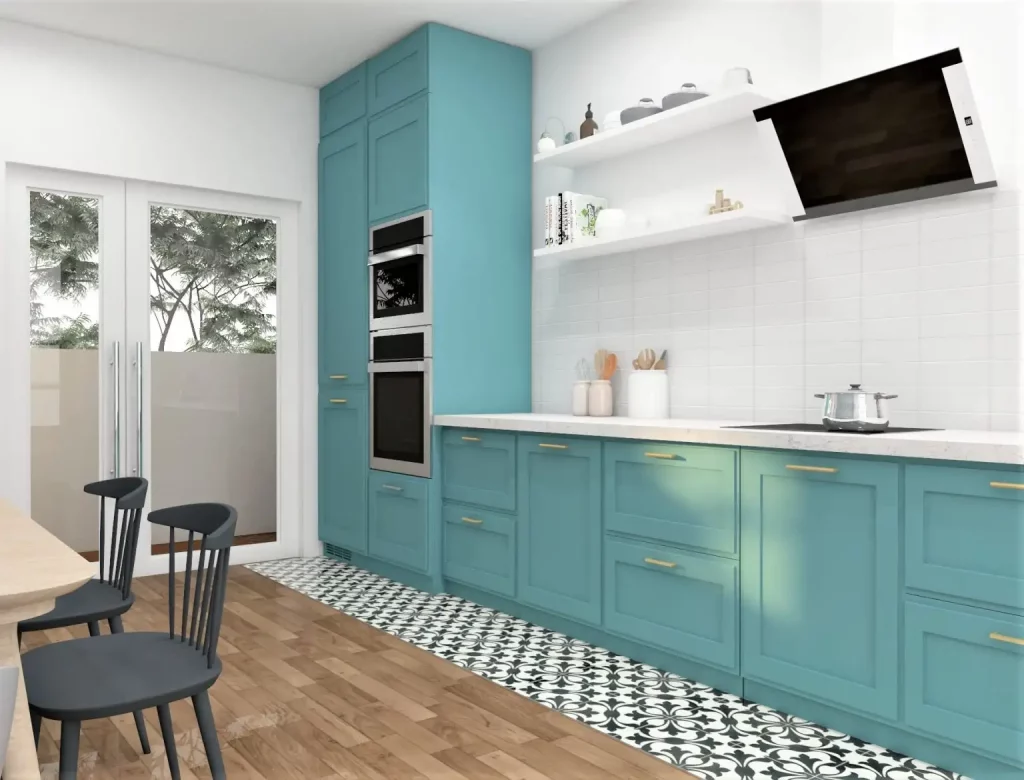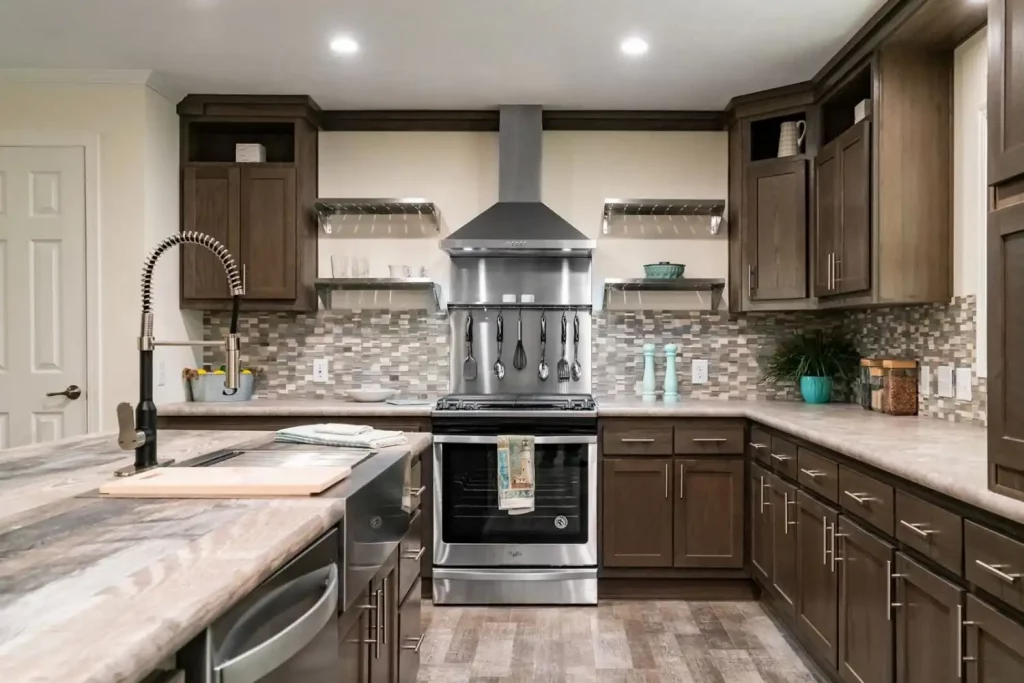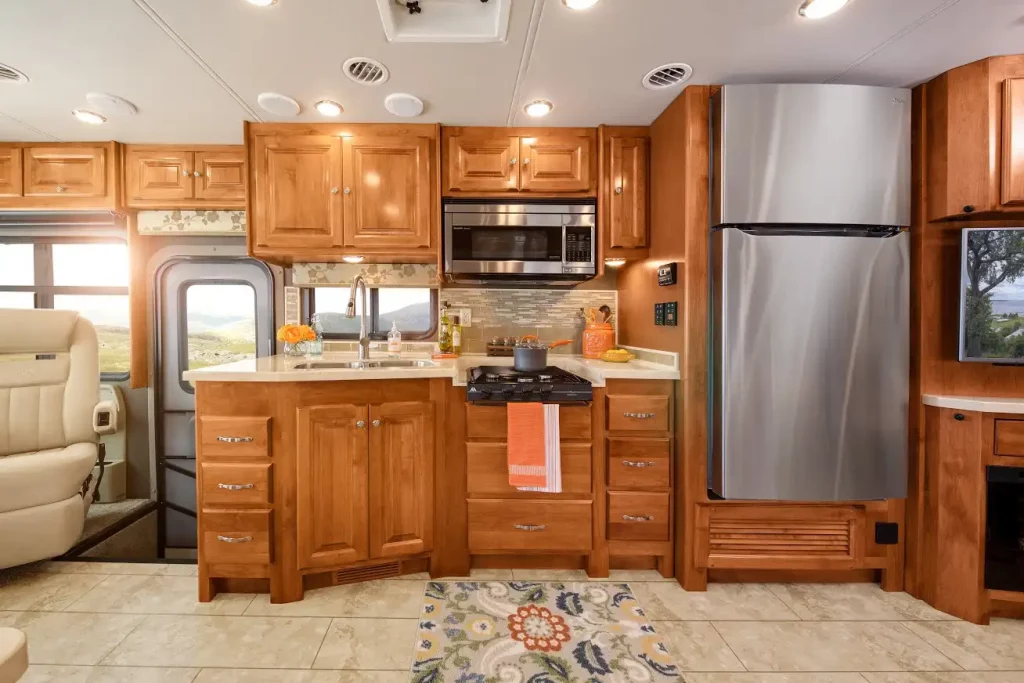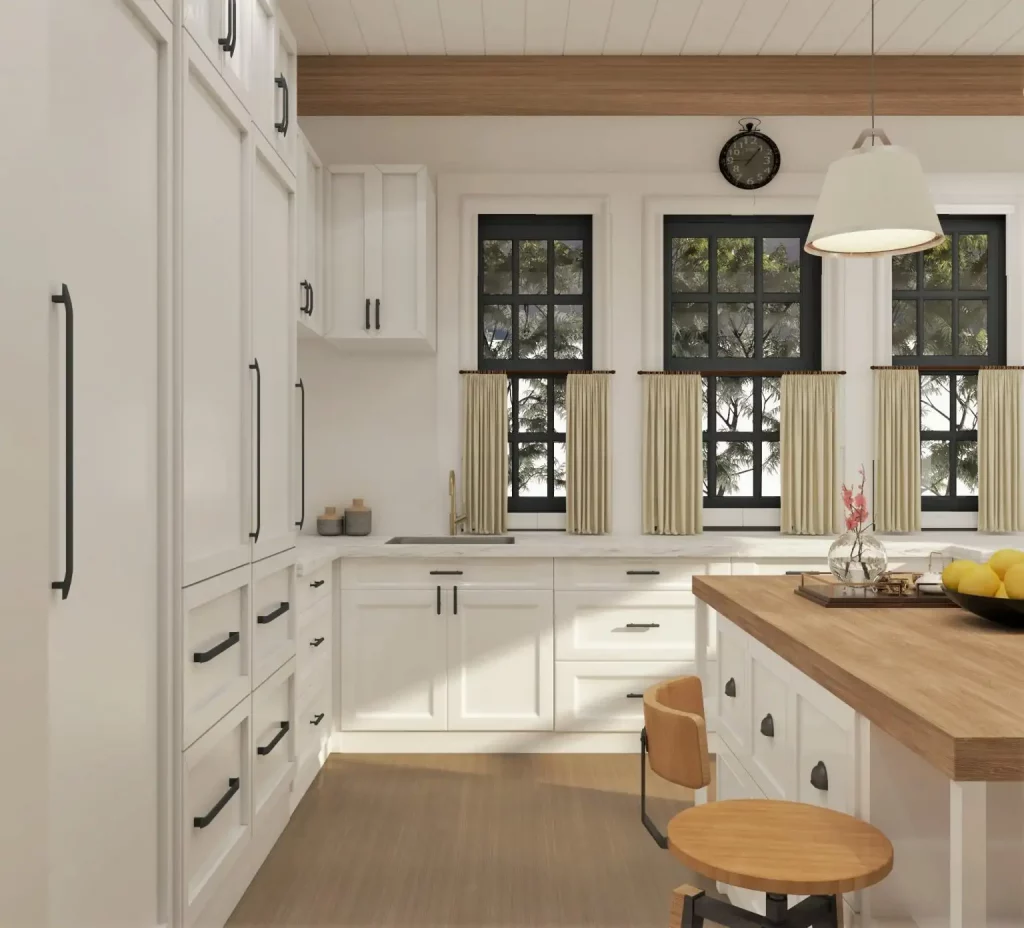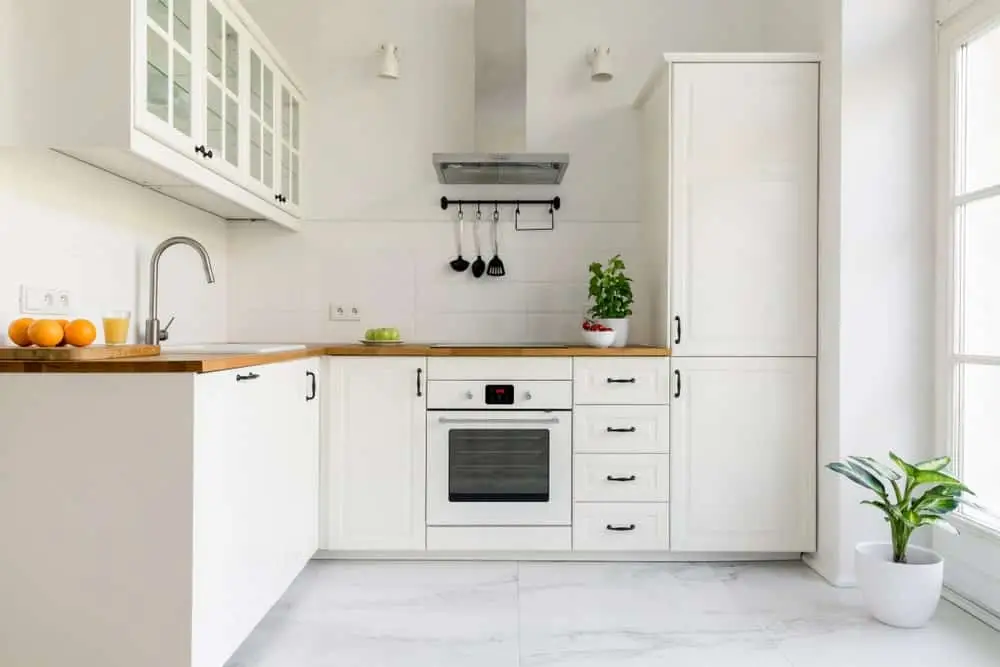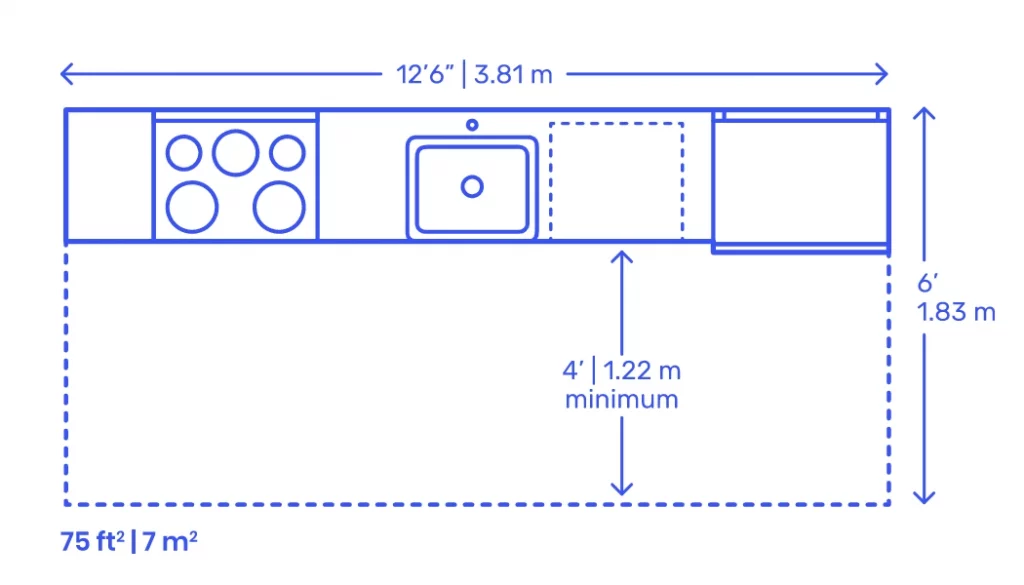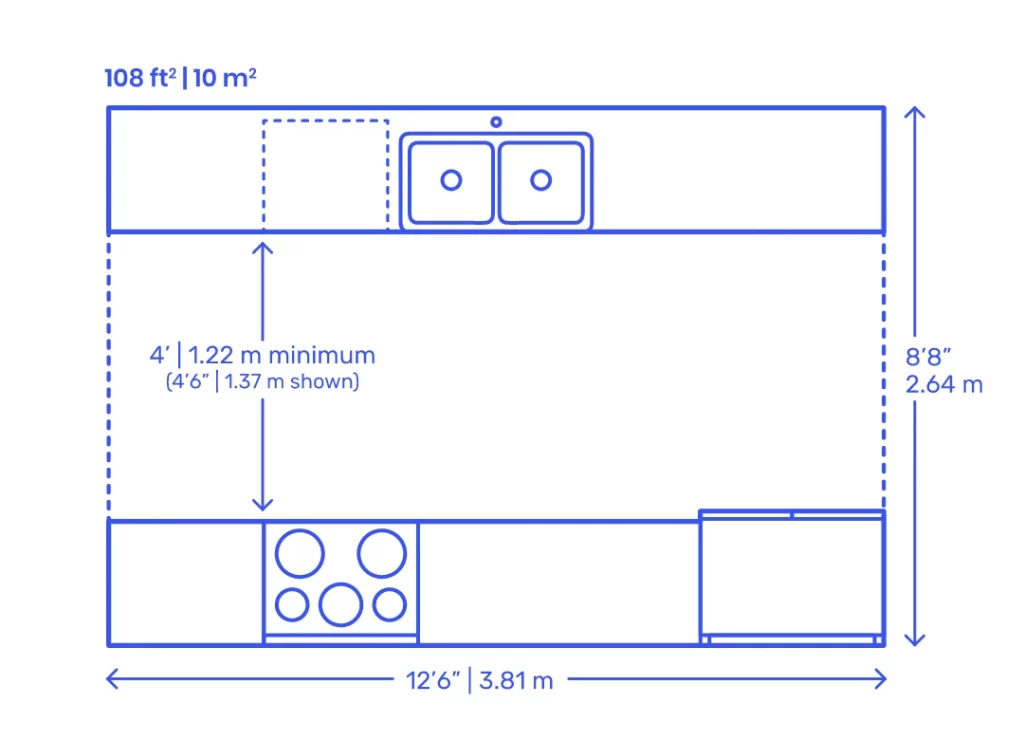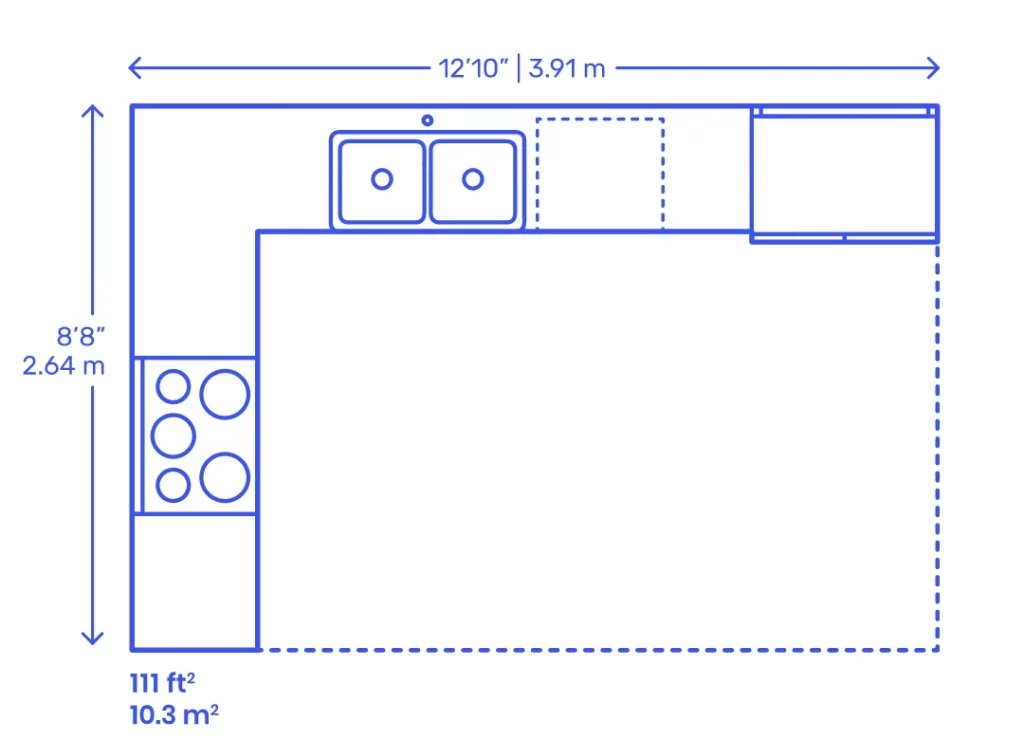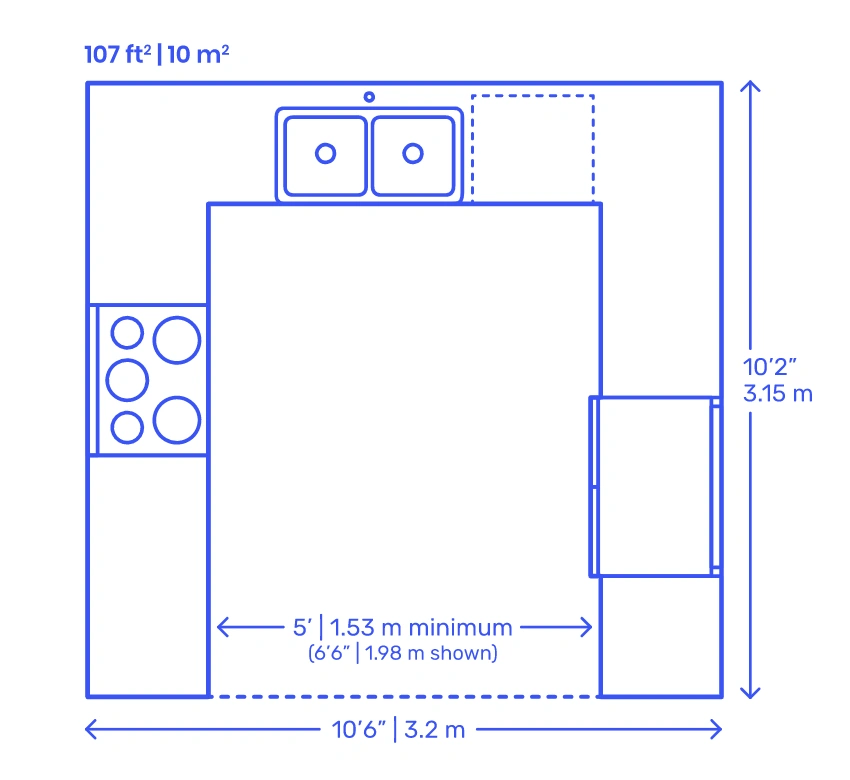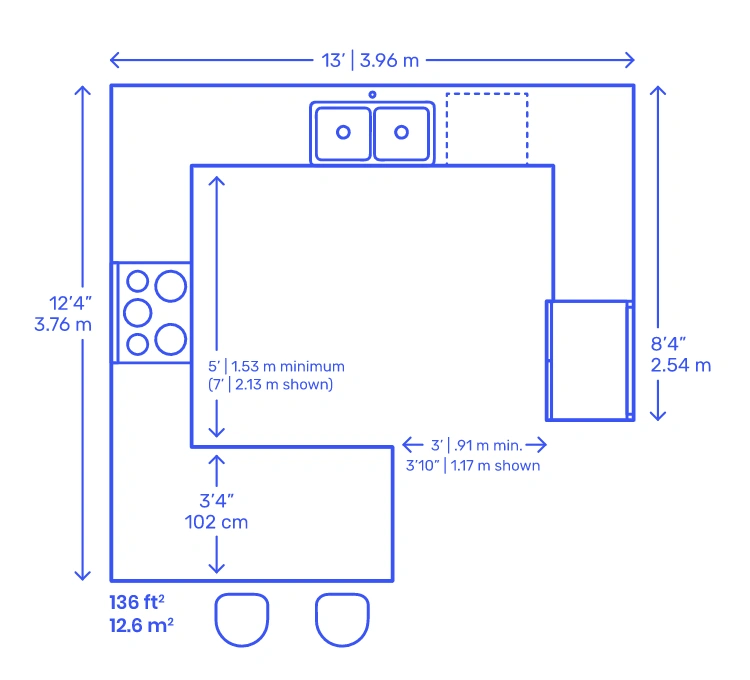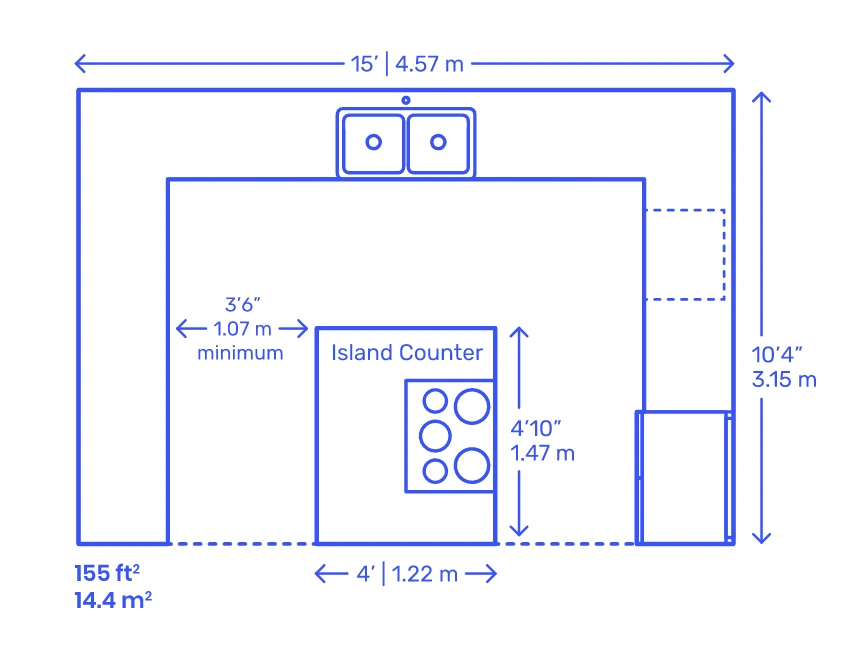Table of Contents
Average Kitchen Sizes
The average size of an American kitchen has greatly improved thanks to the modern designs and cultures. The evolution from the miniature kitchens has been remarkable and it has been characterized by the degree of opulence, style and historical design norms.
Large, luxury homes have tended to have large kitchens either attached or separate from the home. Another factor is regional or demographical factors. For example, suburban homes tend to have larger kitchens than urban homes. Homes on the Southwest side of America have a tendency of having bigger kitchen designs than the ones on the North East side.
In the USA kitchens are used for diverse purposes other than cooking, and food preparations, they are used for dining with guests and friends. The children also sit on the kitchen islands as they do their assignments and bond with their parents.
Read also – How To Design A Kitchen?
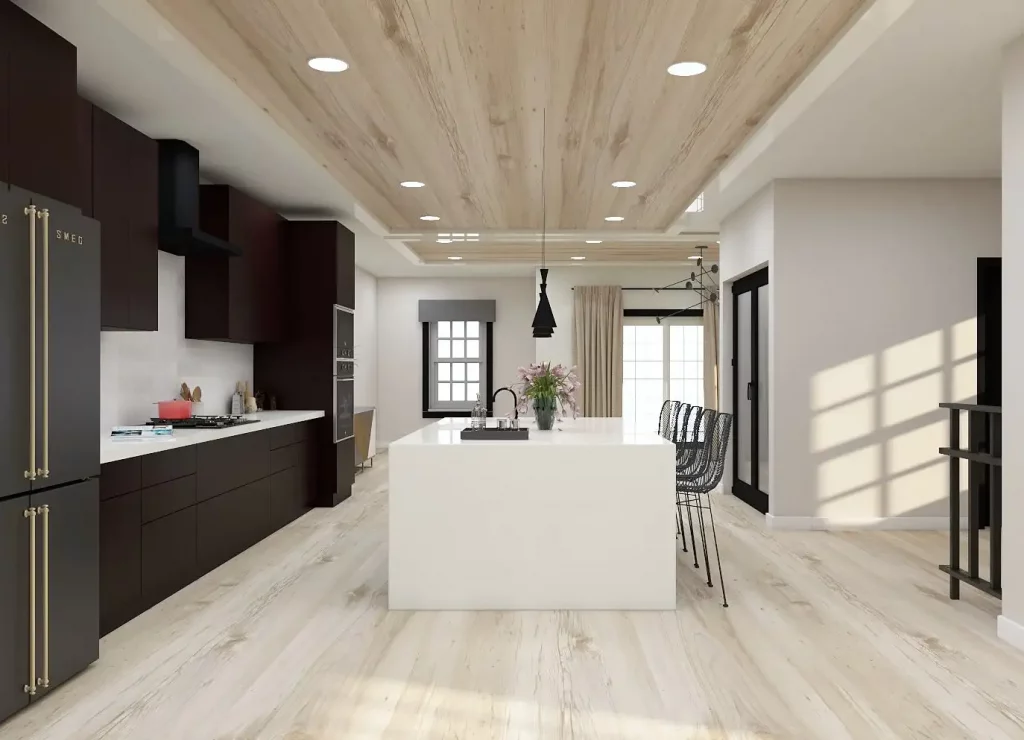
Image Credit: foyr.com
Evolution of Kitchens
Prior to the 1900s:
The kitchen was smaller than today and it occupied a smaller portion of the home. Appliances including stoves were huge and free standing and occupied most of the spaces. Food storage was done in a separate pantry area while the kitchen was a largely hidden space. The only exception was in the rural kitchen farms where the large space was used for serving meals.
In the early 1900s:
The home sizes gradually increased until the 1950s. The kitchens remained fairly small rooms. Space-saving gas electric appliances and efficient cabinetry began to make the kitchens more functional. Small informal dining areas in the kitchen became more common. It further led to the creation of larger kitchens.
From the 1950s to the 1980s:
The kitchen sizes extended. As built-in appliances increased, efficient cabinetry increased making the kitchen more practical. Informal meals began to be served on smaller tables or on breakfast nooks.
From the 1980s to the present:
The sizes of the kitchen floor plans improved to 2600 square feet. The kitchen sizes presently have increased to serve social functions. In-built industrial homes have larger dining spaces and open spaces for entertainment. Old homes have been remodeled to incorporate more spaces.
Kitchens that are 400 square feet or larger are quite common in larger homes. The kitchen area is now part of the open-concept design blurring the distinction between the kitchen and the living room.
In 2020s:
The average size of a kitchen room is presumed to be 150 square feet. However other factors would determine the size such as the size of the family, and whether you would need to entertain them on a regular basis would translate to a bigger space and an open floor plan.
Historical kitchen dimensions
- Pre-20th century kitchens were typically small and utilitarian, often located away from main living areas, with separate pantry areas for food storage.
- The average kitchen size during the early to mid-20th century grew to around 80-100 square feet, reflecting a shift towards more family-centered living and the incorporation of small dining spaces.
- Late 20th century kitchens evolved into social hubs, leading to sizes ranging from 150 to 400 square feet as open-concept designs became popular.
- Kitchen designs in the post-war period began incorporating efficient cabinetry and built-in appliances, facilitating a more modern use of space.
- The average dimensions of kitchens have evolved significantly, with small kitchens measuring 70 square feet or less, mid-size kitchens ranging from 100 to 200 square feet, and large kitchens exceeding 200 square feet.
Modern kitchen trends
- Open-concept kitchens have been a dominant trend in home design, offering an airy feel that connects cooking spaces with dining and living areas, thus accommodating social gatherings.
- The resurgence of closed-concept kitchens reflects a growing preference for privacy and defined cooking spaces, indicating a potential shift in kitchen layout trends.
- Modern kitchens are increasingly designed to balance spaciousness with practicality, catering to the lifestyle needs of inhabitants and facilitating family gatherings.
- The integration of multifunctional elements in kitchen design emphasizes the significance of creating environments that promote comfort and encourage hosting and entertaining.
Read also – What is Kitchen Triangle?
Average Kitchen Sizes by Housing Type
- The average kitchen size in single-family homes typically ranges between 150 to 300 square feet, with smaller homes often featuring kitchens around 150 square feet.
- In late 20th century modern homes, kitchen sizes expanded significantly, now commonly reaching sizes between 150 and 400 square feet to accommodate open-concept living.
- Tiny houses can have kitchens that consume a larger proportion of their overall space, ranging from 10 to 15% of the total area, depending on the size and layout of the house.
- Standard kitchen sizes for smaller homes are generally around 10×10 feet, while larger homes might have kitchens approximately 15×20 feet.
- Kitchenettes, often found in smaller living spaces, average about 58x24x36 inches, providing basic appliances suitable for cooking in limited areas.
The Average Kitchen Size in Standard Homes
- A standard kitchen in a single-family home typically ranges from 150 to 300 square feet, providing ample space for cooking and storage.
- In smaller homes, kitchens often measure around 150 square feet, ensuring functionality while optimizing available space.
- The average kitchen size for a standard home has increased from about 70 square feet in the past to 150 square feet in modern designs.
- Kitchens in larger homes can expand to between 150 and 400 square feet or even larger, reflecting a trend towards open-concept designs that incorporate dining and living areas.
- A classic benchmark for small kitchens is the 10 x 10 kitchen, which measures around 100 square feet or less.
Read also – Average Bedroom Size
Image Credit: foyr.com
The Average Kitchen Size in Trailer Homes
Trailer homes tend to have the same size as standard homes but are slightly smaller. Trailer houses are long and narrow. A standard trailer house is sized 20x 80. Smaller mobile homes are about 14x 70. The common characteristic of trailer homes is their propensity for eat-in-kitchens.
Smaller mobile homes have 80 square feet of kitchens while larger ones have 150 square feet. Regardless of the size, the trailer kitchen will tend to be long and narrow. Instead of 10x 10, they will tend to be 8 x12 or X 16 square feet.
Read also – 80+ Beautiful Modern Kitchen Design Ideas
Image Credit: mhvillage.com
The Average Kitchen Size in a Motor Home
- Approximately 1 million Americans live in motorhomes, making it a significant aspect of recreational living in the U.S.
- The kitchen area in motorhomes tends to share space with the living room, making it difficult to estimate precise kitchen sizes.
- Kitchen sizes in larger mobile homes can be around 150 square feet, while smaller ones typically measure about 80 square feet.
- Motorhome kitchens often have a long and narrow design, differing from the standard 10×10 kitchen size to dimensions such as 8×12 or 8×16 square feet.
- Most kitchen appliances in motorhomes are specifically designed to fit into recreational vehicle spaces, emphasizing the need for efficient use of cubic feet for functionality.
Read also – 15 Best Free Kitchen Design Software
Image Credit: outdoorsy.com
The Average Kitchen Size in a Farmhouse
- A farmhouse that is considered small is between 20 to 24 inches in length.
- The length measurement is taken from one side of the sink to the back of the sink while the width measurement is taken from going in front of the sink. The depth or height of a farmhouse sink is fairly standard.
- The width of the sink is the same as the standard sink as dictated by the width of the countertop. A medium farmhouse sink is between 8-10 inches in height and 33 inches in width and a length of 30 to 40 inches.
- A large farmhouse has a height between 8-10 inches, a width of 33 inches and a length between 40 -60 inches.
Read also – 6 Best Kitchen Decor Ideas
Image Credit: foyr.com
The Average Kitchen Size in an Apartment
- A standard kitchen apartment has five kitchen layouts (G-shape, U-Shape, L-Shape, Galley and One Wall). Every kitchen is distinct and consumes around the same amount of space on average.
- Apartments are normally smaller than the standard house. Thus, their kitchens are also smaller. Most kitchens are under 100square feet.
Read also – 6 Best Kitchen Layout Ideas
Image Credit: homestratosphere.com
1. One Wall Kitchen Size
This layout type is suitable for small houses or limited kitchen spaces. All the kitchen cabinets and appliances are fitted on one wall including the kitchen island. One walled kitchen needs about 8 feet in length to accommodate all the appliances.
2. Galley Kitchen Size
It is also known as a walk-through kitchen and is suitable for small kitchen spaces. In a galley kitchen, two parallel walls of kitchen cabinets and worktop spaces face one another creating a walkaway between one another.
A galley kitchen omits the issue of corner cabinets which can be expensive as they have to be customed. An average gallery kitchen is about 7 to 12 feet in width with four or five feet between the two walls of kitchen cabinets and fixed appliances.
Image Credit: dimensions.com
3. L-Shaped Kitchen Size
It consists of two perpendicular walls of kitchen appliances and cabinets. The average size ranges from 8 to 13 feet in length and 3 to 9 feet in width. The layout is efficient as it is easy to add a dining set or multiple workspaces.
Image Credit: dimensions.com
4. U-Shaped Kitchen Size
- A U-shaped kitchen layout typically has a footprint of around 107 square feet, providing ample storage and counter space across three walls.
- The ideal width of a U-shaped kitchen ranges between 9 to 12 feet, while a clearance of 5 feet is mandatory in the center for ease of movement.
- Incorporating a kitchen island in a U-shaped kitchen can enhance functionality, but at least 3.5 feet of space is needed between the island and surrounding cabinets or appliances.
- A chef can work efficiently in a U-shaped kitchen due to the design, which allows for seamless movement and preparation across three sides of counters.
- While offering significant workspace, the U-shaped layout can be constricting and may not accommodate a dining table or breakfast chairs easily.
Image Credit: dimensions.com
5. Peninsula Kitchen Size
It is similar to a U shaped kitchen or a kitchen with an island. However, the third wall of the horseshoe shape is not fitted with kitchen cabinets or compared to the kitchen with an island as the island is connected making a peninsula instead of a free-standing kitchen island. The dimension of the peninsula kitchen is similar to a horseshoe-shaped kitchen.
Image Credit: dimensions.com
6. Island Kitchen Size
It comprises a large free-standing structure that adds an extra workstation. It can be used as a place to dine, kitchen sink or food storage. An average kitchen island is 3 by 6.5 feet.
Read also – 50 Best Kitchen Island Design Ideas
Image Credit: dimensions.com
The Average Kitchen Size in a Tiny House
- Tiny houses are categorized into two sizes: those under 100 square feet and those on wheels that are generally smaller than 200 square feet.
- The kitchen space in tiny homes, particularly those under 600 square feet, often requires creative solutions for efficient cabinetry and smart design.
- Tiny homes frequently utilize a galley kitchen layout, which incorporates essential built-in appliances and a compact food preparation area for optimal use of limited space.
- Container homes, which have narrow layouts, generally feature eat-in kitchens ranging from 80 to 150 square feet, emphasizing clever kitchen designs to maintain an open feel.
Read also – 21 Best Kitchen Counter Decor Ideas
Image Credit: thespruce.com
An Average Kitchenette Size
A kitchenette is a small-sized kitchen with several appliances. Mostly a fridge, a tiny sink and a microwave. They are often used in motel rooms and other small temporary living spaces. An average kitchenette is about 58x 24×36. A kitchenette unit may have a sink and a space for a microwave. The fridge is normally placed beneath the cabinet.
1. Appliance Sizes
Every home appliance has a different size than it consumes. The fridge for example is divided into different types (The bottom freezer, top freezer, French door and side by side). The bottom freezer has a freezer at the base with an average size of about 29 1/2 inches to 32 3/4 in width and 67 to 70 inches in height and 33 3/8 inches in depth.
The top freezer literally has a freezer at the top and it is the most common type. It is slightly smaller than the one with the freezer at the bottom. Its size is relatively 28 3/4 to 32 3/4 inches in width and 61 ¾ to 66 ¼ inches in height and 28 ¾ to 34 ½ inches in depth.
The French door has two doors on the top and the lower freezer. The freezer is 29 3/8 to 34 5/8 inches in depth. The side by side has two doors. One side is the freezer while the other is the fridge.
It has the largest range with 32 ¾ to 39 ¾ in width and 65 7/8 to 71 ¼ inches in height and 29 ¾ to 31 1/8 inches in depth. There are three oven sizes for a regular oven (24 inches, 27 inches and 30 inches). 24 inches is the most common with countertops and cabinets.
Read also – 20 Best Kitchen Backsplash Ideas
2. Stovetop
When one has a different cooking top and a built-in oven, the spacing will be different. A stovetop is normally placed inside a cutout countertop. A stove is 30 inches by 24 inches. Sometimes, they are smaller by an inch on the sides to ensure they fit on the countertop without overlapping.
3. Dimensions for an Ergonomic Kitchen
The dimensions of the size of your kitchen are based on convenience and comfort. A kitchen is suitable to work in and fits the physical stature. The critical details to check include the height of the stove should be comfortable for the back. The elbows should be four inches higher than the kitchen countertop.
4. Ghost Kitchen
It is a food prep area. It’s different from a virtual kitchen and it’s easy for individuals to confuse the two. A ghost kitchen does not require mortar and brick for home improvement. Thus, saves resources and maximizes the space.
Kitchen Remodeling Considerations
- The cost of remodeling a 10X10 square foot kitchen can range from $15,000 to $30,000, depending on the desired style and features.
- When planning a kitchen layout, configurations such as U-shaped, L-shaped, and galley kitchens must be considered to maximize functionality and flow.
Average Costs of Kitchen Remodels
- The cost of remodeling a 10X10 square feet kitchen may range from $15,000 to $30,000 depending on the desired style and materials chosen.
- Benchmark remodeling pricing typically falls between 5% to 15% of a homes asset value.
- Hiring a professional kitchen designer can cost between $100 to $1,000, based on their experience and the extent of remodel work.
- On average, homeowners can expect to recoup 50-60% of their kitchen remodel cost if they decide to sell their home after the renovation.
Space Planning Principles
- Efficient kitchen layouts can create effective work zones and should consider the classic kitchen triangle principle, adapted for modern needs to accommodate various activities.
- Galley kitchen designs require a minimum clearance of four to five feet between work surfaces to ensure comfortable movement and efficient workflow.
- Planning for adequate clearance around kitchen appliances and maintaining sufficient open space for traffic flow are critical for efficient kitchen design.
- Open plan layouts facilitate better integration with living areas, enhancing functionality and promoting social interaction in kitchen spaces.
When remodeling a kitchen, you can decide to add space, change the countertop to a marble one or purchase a new appliance.
1. Lighting
Proper lighting is essential for food preparation. It also sets the right mood and a perfect ambience for the kitchen. Different lighting fixtures can be installed in a new home for more insulation such as pendant lighting, wall fixtures and scones. It also depends on the types of kitchens and the average home size.
2. Storage
Kitchen wares can be stored in the closets, shelves and snuggeries. It’s also essential to isolate a space for dry foods. Shelves and closets will bear further distance and bone can maximize the space by incorporating fresh overhead closets and shelves. The sole purpose is to reduce clutter for a polished appeal.
3. Flooring
Effective kitchen flooring should include safer and lighter accoutrements as they make the spaces commodious. It’s also effective as it’s easier to spot food tumbles. The effective flooring types that one can use include vinyl, Demitasse pipe, linoleum and hardwood. Vinyl and Linoleum are effective as they’re water-resistant and are available in different designs. Demitasse is effective in continuity and beauty.
4. Ventilation
To fight the smells spreading to the living room area it’s effective in installing a top-notch hood and large windows for proper rotation.
Read also – Standard Bathtub Dimensions For Every Type of Tub
Factors Influencing Kitchen Size
Family lifestyle and size
- The ideal kitchen size is influenced by family size, with larger families often requiring bigger kitchens to accommodate more people for food preparation and socializing.
- A smaller kitchen may be perfectly adequate for a single person or couple, especially if their cooking habits are infrequent.
- Lifestyle habits, such as entertaining guests, can necessitate a larger kitchen space to facilitate social interactions and ease of movement.
Technological Advancements
- Technological advancements have led to the incorporation of smart built-in appliances in modern kitchens, significantly enhancing functionality and efficiency.
- The rise of larger kitchen appliances, such as double ovens and larger refrigerators, necessitates increased space and counter area to accommodate these features.
- Future kitchen designs emphasize technology with innovations such as AI-powered appliances, voice-controlled space management, and automated food storage systems.
- The trend toward multifunctional kitchen islands illustrates the desire for versatile kitchen spaces that can serve various purposes, including food preparation and social interaction.
- Increasing sophistication in modern kitchen design is reflected in the need for expanded cabinet space and professional-grade cooking areas that keep pace with technological advancements.
Regional Variations
- The Middle Atlantic region (Pennsylvania and New York) has the highest average kitchen size at 170 square feet.
- Kitchens in the South Atlantic region (including Maryland, West Virginia, Georgia, Florida, North and South Carolina) average 166 square feet in size.
- The West South Central region (Texas, Oklahoma, Arkansas, and Louisiana) features kitchens averaging 165 square feet.
- Kitchens in the Mountain region (Montana, Idaho, Wyoming, Nevada, Utah, Colorado, Arizona, and New Mexico) have an average size of 162 square feet.
- Multi-storey homes in the West South Central region have the largest overall kitchen size, averaging 184 square feet.
Read also – 20 Common Kitchen Design Mistakes To Avoid
Tips for Customizing Kitchen Layouts
Maximizing Space Efficiency
- Modern kitchen designs emphasize the integration of built-in appliances and smart solutions, which contribute to maximizing both functionality and space efficiency.
- In many Asian countries, compact kitchen layouts are common, often under 100 square feet, demonstrating a strong focus on efficient use of limited space.
- European kitchens prioritize storage and practicality within a smaller footprint, averaging between 120 and 140 square feet.
- Efficient kitchen layouts, such as the galley kitchen, optimize workflow by keeping essential components within reach and maximizing storage and shelving space.
- The average kitchen size in U.S. suburban homes has grown significantly, reflecting a trend towards larger, open-concept designs that enhance social interaction while optimizing available space.
Incorporating Storage Solutions
- Incorporating antique buffets into kitchen design can enhance storage solutions while adding a unique aesthetic element.
- Open shelving is a modern storage solution that not only keeps dishes handy but also reduces visual clutter, creating a more expansive feel in the kitchen.
- The trend of eclectic furniture styles allows for diverse storage options that work in harmony with the overall kitchen design while maximizing utility.
Reflecting Personal Style
- Incorporating unique backsplashes can significantly enhance the personal style of your kitchen, allowing for creative expression through color and design.
- Utilizing sheer curtains and adding greenery can improve the ambiance and personal feel of a small kitchen, prioritizing natural light as a stylistic element.
- Emphasizing functionality while integrating stylish elements, such as multi-functional appliances and spaces, can help create a kitchen that not only serves as a cooking area but also reflects personal style and lifestyle needs. The square footage of your kitchen plays a vital role in determining how effectively you can balance these elements while ensuring the space remains practical and inviting.
Conclusion:
Creating Your Ideal Kitchen
When you are renovating your beautiful kitchen and dreading the transitional factor, consider incorporating your favorite style into a modern home or vice versa. It is essential to consider your house size and your kitchen space before making major remodels
When in doubt about choosing your design elements, we suggest you turn to the user-friendly Foyr Neo software that is designed to help kitchen and bath designers, homeowners and interior designers alike. You can select your preferred floor plans, choose the paint colors for the walls, pick your furniture, and basically design your kitchen on a 3D model. It will give you an accurate rendering of what your kitchen design is going to look like after the makeover.
FAQs
What is the size of a standard kitchen?
A standard kitchen in an average single-family home typically ranges from 150 to 300 square feet. This size provides enough room for essential appliances, adequate counter space, and comfortable movement. However, the ideal dimensions can vary significantly based on the home’s overall size, layout, and the household’s specific needs and cooking habits.
Is a 12 by 12 kitchen small?
A 12×12 kitchen, which measures 144 square feet, is considered a moderately sized kitchen. While it is smaller than the average for large suburban homes, it offers a functional layout for apartments and smaller houses. This size can comfortably accommodate all necessary appliances and provides a workable space for daily meal preparation without feeling too cramped.
Is a 10×10 kitchen small?
Yes, a 10×10 kitchen, or 100 square feet, is widely considered the benchmark for a small kitchen. This compact size is very common in apartments, condos, and smaller homes. Although limited in space, a well-designed 10×10 layout can still be highly functional, efficiently housing all essential appliances and offering just enough workspace for daily cooking tasks.
What is the 3×4 kitchen rule?
The 3×4 kitchen rule is a design guideline ensuring a safe and efficient workspace, primarily by maintaining proper clearances. It recommends a minimum of 3 feet of countertop space on each side of a cooktop or range and at least 4 feet of clear walkway in front of appliances to allow for easy movement and door openings.
What is the best size for a kitchen?
There is no single “best” size for a kitchen, as the ideal dimensions depend entirely on individual needs. Factors to consider include your family size, cooking habits, and entertainment style. A large, open-concept kitchen may be perfect for one household, while a smaller, highly efficient galley kitchen might be better suited for another’s lifestyle.
Is a 10×12 kitchen small?
A 10×12 kitchen, at 120 square feet, is generally considered a small to medium-sized kitchen. It is a common dimension for apartments, townhouses, and smaller single-family homes. While not large, this size offers more flexibility than a 10×10 layout, providing extra room for storage or a small dining nook, making it quite functional.









